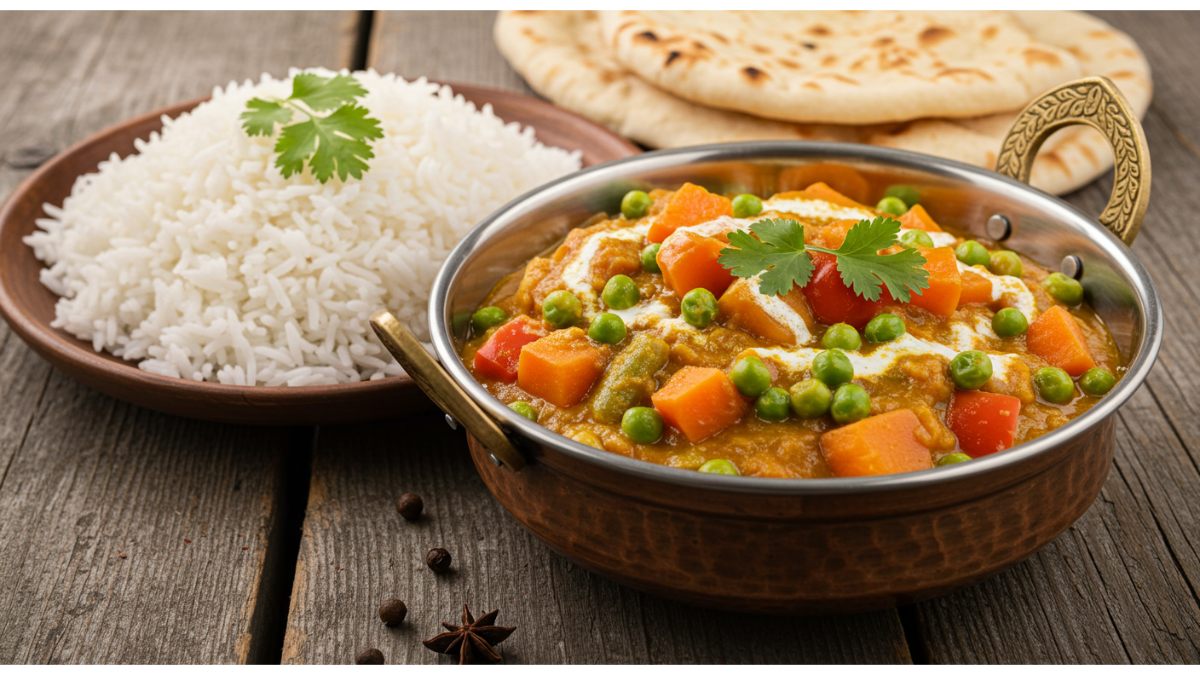If you’re craving a cozy bowl of vegetable curry, this one-pot version delivers restaurant-style flavor with simple steps and everyday spices. It’s richly aromatic (not fiery by default), easy to customize with whatever produce you have, and turns creamy if you choose to add coconut milk. Ideal for weeknights, meal prep, and anyone who loves a colorful, nourishing dinner that comes together without fuss.
This vegetable curry follows a fail-safe method: bloom cumin seeds in hot oil to build a toasty base, sauté onion, garlic, and ginger until fragrant, cook down tomatoes with spices into a glossy masala, then simmer mixed vegetables until tender. Finish with garam masala for brightness and cilantro for a fresh, green lift.
Why You’ll Love This Vegetable Curry
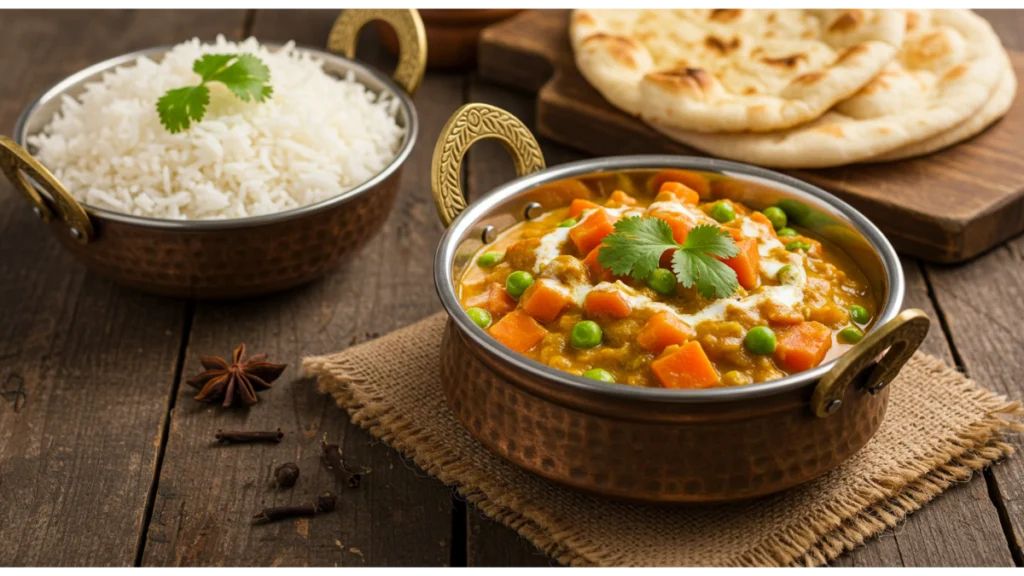
- One pot, less mess: Everything cooks in a single pan for minimal cleanup.
- Big flavor, simple steps: Turmeric, cumin, coriander, and garam masala create that classic curry depth—no complicated techniques.
- Use-what-you-have friendly: Carrots, peas, potatoes, bell peppers… the method works with many vegetables.
- Creamy if you want it: Coconut milk is optional; use it for a silky finish or skip for a lighter stew-like sauce.
- Excellent for leftovers: Like many curries, it tastes even better the next day as the spices meld.
Ingredients for Vegetable Curry
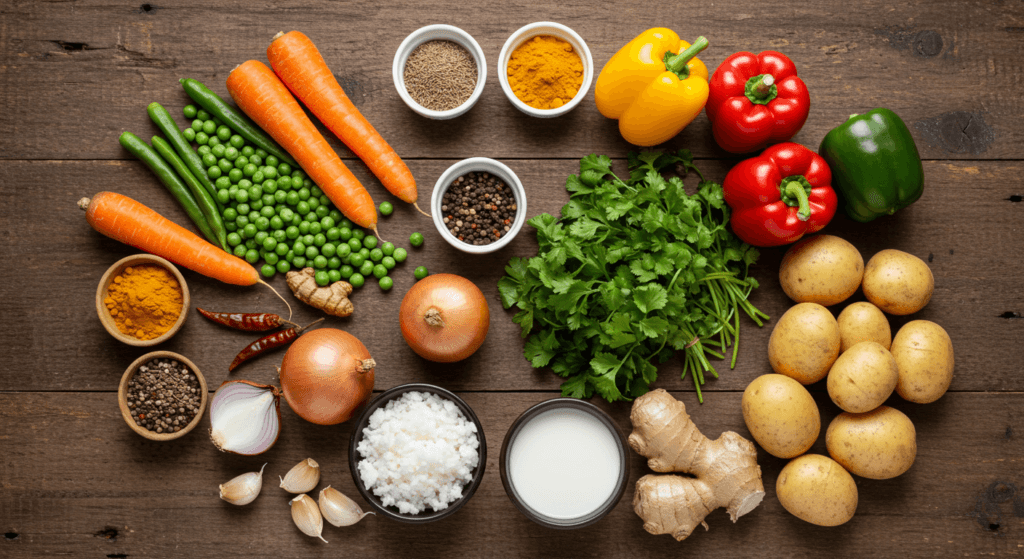
To make a delicious vegetable curry, gather the following ingredients:
- 2 tablespoons vegetable oil (or ghee)
- 1 onion, finely chopped
- 2 cloves garlic, minced
- 1-inch ginger, grated
- 2 medium tomatoes, chopped
- 1 teaspoon turmeric powder
- 1 teaspoon cumin seeds
- 1 teaspoon coriander powder
- 1 teaspoon garam masala
- Salt to taste
- 4 cups mixed vegetables (carrots, peas, potatoes, bell peppers, etc.)
- 1 cup coconut milk (optional)
- Fresh cilantro for garnish
Step-by-Step Instructions
- Heat the oil and bloom cumin: Warm the oil in a wide pot over medium heat. Add the cumin seeds and let them sizzle for a few seconds until fragrant.
- Sauté the aromatics: Stir in the finely chopped onion; cook until translucent, about 5 minutes. Add the minced garlic and grated ginger; sauté briefly without burning.
- Tomatoes and spices: Add the chopped tomatoes along with turmeric powder, coriander powder, and salt. Cook 5–7 minutes, stirring, until the tomatoes break down into a thick, glossy masala.
- Add the mixed vegetables: Tip in the mixed vegetables and toss to coat them evenly in the masala.
- Simmer until tender: Pour in enough water to just cover the vegetables. Bring to a boil, reduce to a gentle simmer, and cook 15–20 minutes, or until the vegetables are fork-tender.
- Optional creaminess: For a richer finish, stir in the coconut milk and simmer 5 minutes to marry the flavors.
- Finish with garam masala: Sprinkle in the garam masala and stir. Taste and adjust salt if needed.
- Garnish and serve: Remove from heat, shower with chopped fresh cilantro, and serve hot with rice or flatbread.
Pro Tips for Success
- Don’t skip the cumin bloom: Sizzling the seeds in oil releases aromatic compounds that anchor the curry’s flavor.
- Keep onions pale: Translucent (not deeply browned) onions give a lighter, balanced base for vegetable-focused curries.
- Smart knife work: Cut denser veg (potatoes, carrots) slightly smaller than quick-cook veg (bell peppers, peas) so everything finishes together.
- Mind the waterline: Add just enough liquid to cover; too much can dilute flavor. You can always add a splash later.
- Add garam masala at the end: It’s a finishing spice—late addition preserves its vivid aroma.
- Choose your texture: Coconut milk yields a lush, velvety sauce; without it, you’ll have a lighter, brothy curry.
Nutrition Facts (Per Serving)
| Nutrient | Per serving* |
|---|---|
| Calories | ≈ 200 kcal |
| Total Fat | ≈ 10 g |
| Saturated Fat | ≈ 5 g |
| Cholesterol | 0 mg |
| Sodium | ≈ 300 mg |
| Carbohydrates | ≈ 28 g |
| Fiber | ≈ 6 g |
| Sugars | ≈ 5 g |
| Protein | ≈ 4 g |
*Estimated per ~1 cup/240 g serving. Values vary with exact brands, oil amount, and whether coconut milk is used. For precise needs, calculate with your specific ingredients.
Benefits of Vegetable Curry
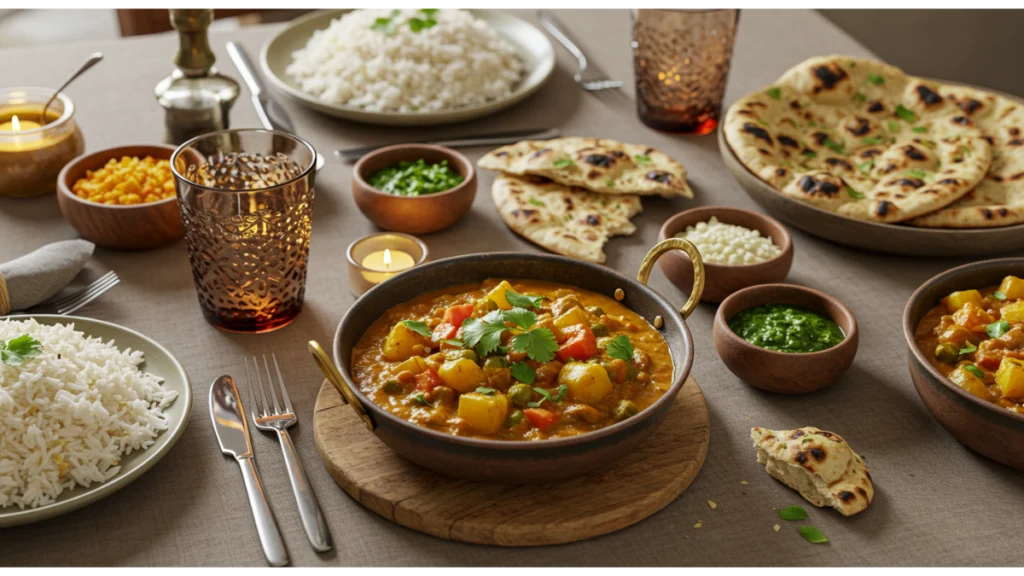
FAQ About Vegetable Curry
How do I keep the vegetables from turning mushy?
Cut dense vegetables (like potatoes and carrots) a bit smaller and add them early, while quick-cooking veg (like bell peppers and peas) can be slightly larger. Keep the simmer gentle and stop as soon as everything is just tender—carryover heat will finish the job.
Can I use frozen vegetables?
Yes. Add them straight from the freezer. They release a little water, so finish uncovered for a few minutes to concentrate the sauce before stirring in the garam masala.
What’s the best way to make it creamy without dairy?
The optional coconut milk already provides a lush, dairy-free finish. If you’re out, blend a spoonful of the cooked vegetables with some cooking liquid and stir it back in for natural body.
Can I make vegetable curry ahead?
Absolutely. Like many curries, it improves after a rest. Cook, cool, and refrigerate. Reheat gently with a splash of water and finish with fresh cilantro to revive the flavor.
What should I serve with it for a complete meal?
Basmati rice or naan are classic. Add a crunchy salad and yogurt or raita for balance. For a bigger spread, pair with a quick lentil dal and some quick-pickled onions.
Optional Substitution Notes
- Oil vs. ghee: Ghee lends a deeper, buttery note; vegetable oil keeps it lighter and fully plant-based.
- No coconut milk: Use vegetable broth and, at the end, blend a little of the curry to thicken naturally.
- More protein without changing the base recipe: Serve your vegetable curry alongside cooked lentils or seared tofu (as a side, not added to the ingredient list).
Expert Spice Tips
- Aroma extraction: Briefly blooming cumin seeds in fat releases aldehydes and terpenes that create a toasty foundation.
- Turmeric and color: Cooking turmeric with fat and tomato mellows bitterness and sets a vibrant golden hue.
- Garam masala timing: It’s finely ground and aromatic—adding it at the end preserves those volatile notes.
Final Thoughts
This vegetable curry is a true weeknight hero: budget-friendly, flexible, and deeply satisfying. With a warm spice base and straightforward steps, it’s a recipe you’ll return to again and again. Keep it light or make it creamy, serve with rice or flatbread, and stash leftovers for tomorrow. The colors, aroma, and comfort factor make it as beautiful on the table as it is delicious in the bowl.
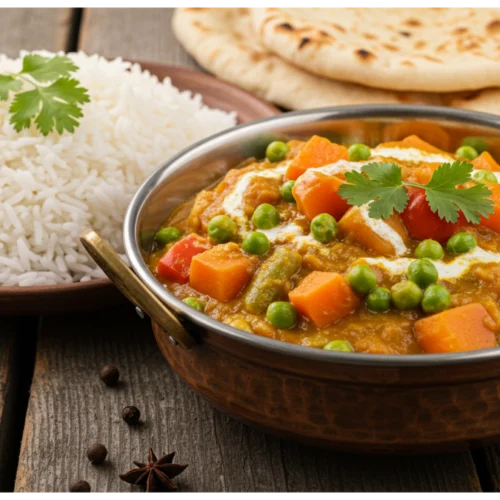
Easy Vegetable Curry (One-Pot, Super Flavorful)
Ingredients
Base & Masala
- 2 tbsp vegetable oil (or ghee)
- 1 medium onion finely chopped
- 2 cloves garlic minced
- 1 inch fresh ginger grated
- 2 medium tomatoes chopped
- 1 tsp turmeric powder
- 1 tsp cumin seeds for blooming
- 1 tsp coriander powder
- 4 cups mixed vegetables carrots, peas, potatoes, bell peppers, etc., chopped
- 2 cups water or as needed to just cover vegetables
- 1 cup coconut milk optional, for creaminess
- 1 tsp garam masala add at the end
- salt to taste
- 2 tbsp fresh cilantro chopped, for garnish
Instructions
- Bloom the cumin: Heat oil in a wide pot over medium heat. Add cumin seeds and let them sizzle for a few seconds until fragrant.
- Sauté aromatics: Add onion and cook until translucent, about 5 minutes. Stir in garlic and ginger; sauté 30–60 seconds.
- Build the masala: Add tomatoes, turmeric, coriander, and a pinch of salt. Cook 5–7 minutes, stirring, until the tomatoes break down into a thick, glossy masala.
- Add vegetables: Toss in mixed vegetables to coat evenly in the masala.
- Simmer: Pour in enough water to just cover (about 2 cups). Bring to a boil, then reduce to a gentle simmer and cook 15–20 minutes, until vegetables are tender.
- Optional creaminess: Stir in coconut milk and simmer 5 minutes to marry the flavors.
- Finish: Sprinkle in garam masala, taste, and adjust salt.
- Serve: Remove from heat, garnish with chopped cilantro, and enjoy hot with rice or flatbread.

